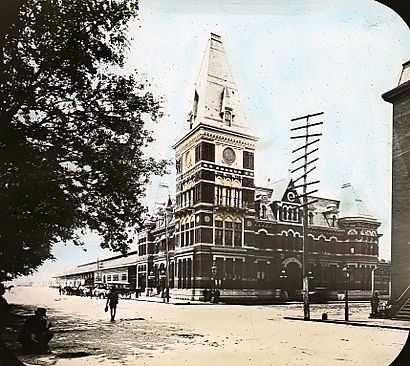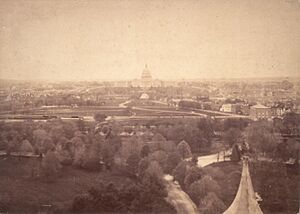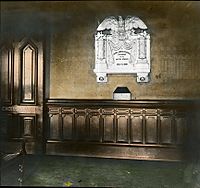Baltimore and Potomac Railroad Station facts for kids
Quick facts for kids
Baltimore and Potomac Railroad Station
Pennsylvania Railroad Station |
|
|---|---|

The B&P Railroad Station
|
|
| Location | Corner of B Street NW & 6th Street NW |
| Owned by | Pennsylvania Railroad |
| Operated by | Baltimore and Potomac Railroad |
| Construction | |
| Structure type | At-grade |
| Architect | Wilson Brothers & Company |
| History | |
| Opened | 1873 |
| Closed | October 14, 1907 (line moved to Union Station) |
| Location | |
| Lua error in Module:Location_map at line 420: attempt to index field 'wikibase' (a nil value). | |
The Baltimore and Potomac Railroad Station, also known as Pennsylvania Railroad Station, was a train station in Washington, D.C.. It was owned by the Pennsylvania Railroad and operated by the Baltimore and Potomac Railroad. The station was open from July 2, 1872, until it closed in 1907.
It was located at 6th Street NW and B Street NW, which is now Constitution Avenue. Today, the West Building of the National Gallery of Art stands on this spot. A very important event happened here: United States President James A. Garfield was shot inside this station. He later died from his injuries.
Contents
About the Station
The main station building was large. It was 120 feet wide on B Street NW and 90 feet wide on 6th Street. The building was 55 feet tall and built in a style called Victorian Gothic. It had red bricks with black mortar.
There were three towers with fancy roofs made of colorful slate. One tower, at the corner, was 100 feet tall and had a clock. Inside, the lower floor had waiting rooms, baggage areas, and ticket offices. Offices were located on the upper floors.
South of the main building, there was a long iron train shed. It was 600 feet long and 120 feet wide. This shed had tall iron columns that held up an arched roof. The roof was decorated with an eagle and other designs.
Train tracks ran south from the station along 6th Street. They connected to other lines that went to Virginia and Maryland.
Station History
Building Approval
The Baltimore and Potomac Railroad opened on July 2, 1872. At first, they used a temporary wooden station. On April 1, 1872, the House of Representatives voted to let the railroad build a permanent station. This new station would be at 6th Street NW and B Street NW.
The bill allowing the station was passed on May 21, 1872. It said the company could use the land to build a passenger station. This station would be for passengers and express freight only.
Construction Details
Work on the station began even before the bill was fully approved. The location was tricky because it used to be a marsh. The station was built over the old Washington City Canal. To make a strong base, workers drove pilings ten feet deep. Then, they laid five feet of strong stone on top.
The new station officially opened in 1873. All construction was finished by July 16, 1874.
President Garfield is Shot
On July 2, 1881, United States President James A. Garfield was getting ready for his summer vacation. As he walked through the station lobby to board a train, a man named Charles Guiteau shot him. President Garfield did not die right away. However, he passed away in September from an infection caused by the gunshot wound.
After the President's death, a special marker was placed on the station wall. A gold star was also put on the floor to show where he was shot. These markers were lost when the station was torn down in 1908.
Today, the James A. Garfield Monument is located about six blocks from where the shooting happened. The National Park Service added new signs in 2019 to mark the site of this important event.
Station Closes and is Torn Down
In 1907, the Baltimore and Potomac Railroad Station closed. Trains began using the new Union Station instead. The Baltimore and Ohio Railway started using Union Station on October 26, 1907. The Pennsylvania Railway followed on November 16, 1907.
On March 15, 1908, the railroad company sold its rights to the station site to the United States government. President Theodore Roosevelt ordered the station to be torn down before December 17, 1908.
What is There Now?
By 1914, the site was chosen for a new building called the George Washington Memorial Building. A special ceremony took place in 1921 to lay the first stone for this building. But the building was never finished.
In 1937, it was decided that the site would be used for the National Gallery of Art. Construction began that same year. On August 21, 1937, workers digging up the old cornerstone found a small metal box. Inside the box was a large gold star. People believed this was the same gold star that marked the spot where President Garfield was shot.
The West Building of the National Gallery of Art was completed on the site. President Franklin D. Roosevelt accepted it for the American people on March 17, 1941.
See also
 In Spanish: Baltimore and Potomac Railroad Station para niños
In Spanish: Baltimore and Potomac Railroad Station para niños




